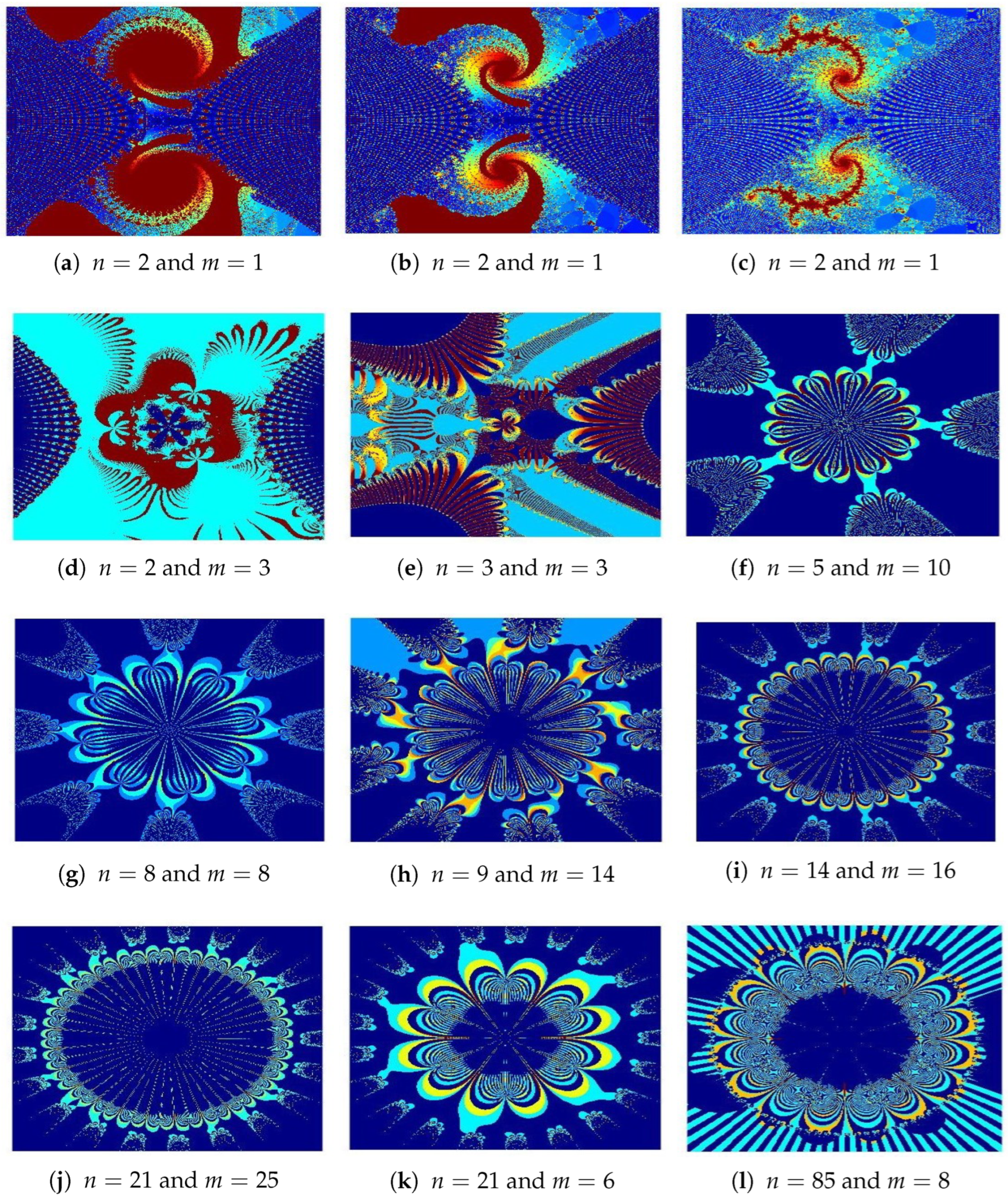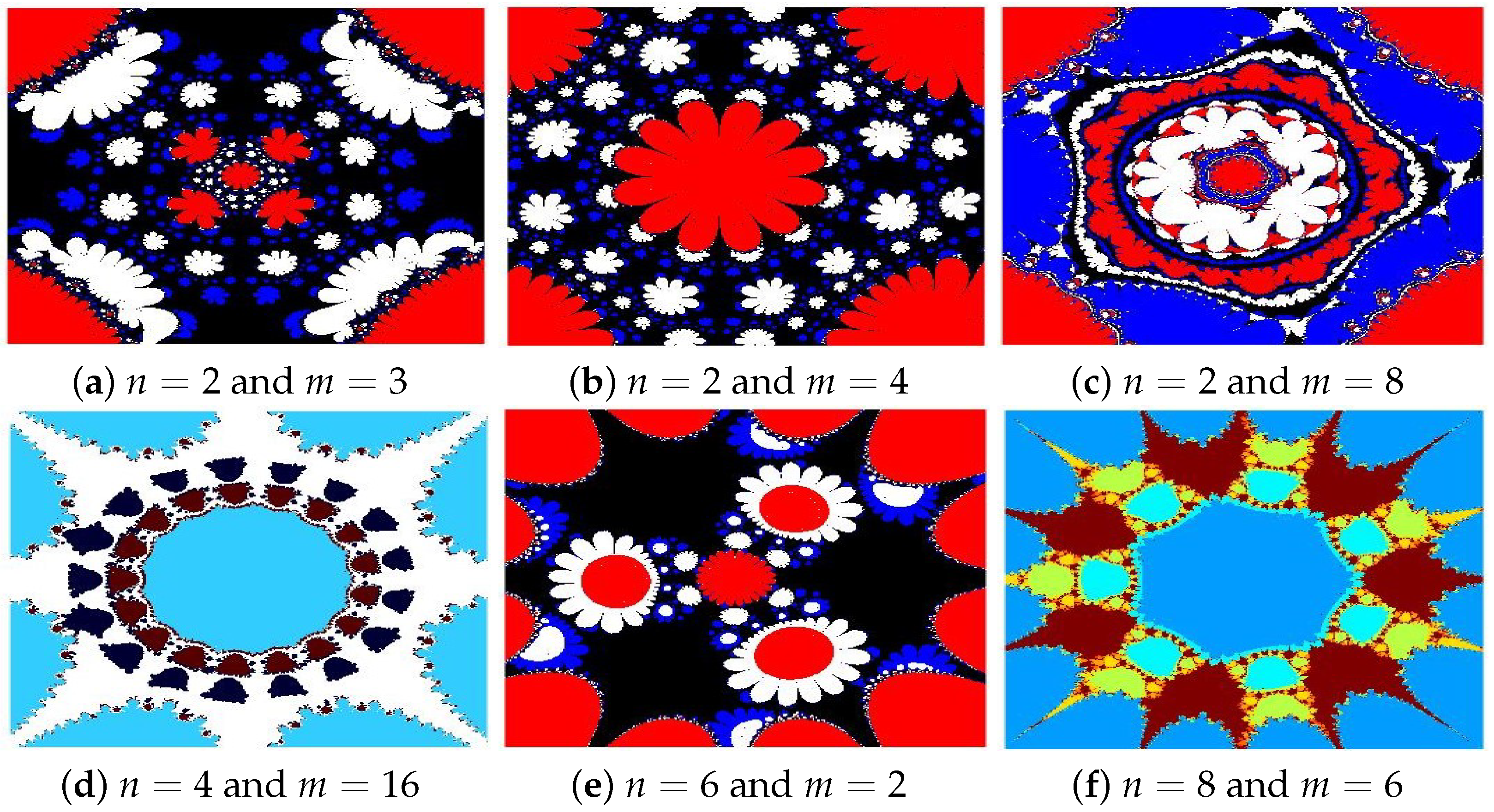Generation of Julia Sets for a Novel Class of Generalized Rational Functions via Generalized Viscosity Iterative Method
Abstract
1. Introduction
2. Preliminaries
3. Main Results
3.1. Escape Criteria for
3.2. Escape Criteria for
4. Graphical Examples
| Algorithm 1 Julia set generation for |
| Input: where -area in which we draw |
| the set; K-maximal number of iterations; ; , where |
| with colormap -color with C colors. |
| Output: Julia set for area A |
| for do |
| R = |
| k=0 |
| while do |
| , where |
| if then break end if |
| k=k+1 |
| color with colormap |
| Algorithm 2 Julia set generation for . |
| Input: where -area in which we |
| draw the set; K-maximal number of iterations; ; , where |
| with colormap -color with C colors. |
| Output: Julia set for area A |
| for do |
| R = |
| k=0 |
| while do |
| , where |
| if then break end if |
| k=k+1 |
| color with colormap |
4.1. Julia Sets for
- (a)
- (b)
- (c)
- (d)
- (e)
- (f)
- (g)
- (h)
- (i)
- (j)
- (k)
- (l)
4.2. Julia Sets for
- (a)
- (b)
- (c)
- (d)
- (e)
- (f)
- (g)
- (h)
- (i)
- The parameters and s are critical in determining the fractals’ structure, scale, and visual properties.
- The convergence criteria used in the iterative schemes significantly influence the image resolution and pixel quality.
- All presented fractals exhibit remarkable innovation and visual appeal, stemming from the sophisticated interplay of the functions and . The resulting designs are not only mathematically significant but also artistically captivating, showcasing the harmonious fusion of computation and creativity.
5. Conclusions
Author Contributions
Funding
Data Availability Statement
Conflicts of Interest
References
- Muthukumar, P.; Balasubramaniam, P. Feedback synchronization of the fractional order reverse butterfly-shaped chaotic system and its application to digital cryptography. Nonlinear Dyn. 2013, 74, 1169–1181. [Google Scholar] [CrossRef]
- Nakamura, K. Iterated inversion system: An algorithm for efficiently visualizing Kleinian groups and extending the possibilities of fractal art. J. Math. Arts 2021, 15, 106–136. [Google Scholar] [CrossRef]
- Ouyang, P.C.; Chung, K.W.; Nicolas, A.; Gdawiec, K. Self-similar fractal drawings inspired by M. C. Escher’s print square limit. ACM Trans. Graphic. 2021, 40, 31. [Google Scholar] [CrossRef]
- Julia, G. Memoire sur l’iteration des fonctions rationnelles. J. Math. Pures Appl. 1918, 8, 47–245. [Google Scholar]
- Antal, S.; Tomar, A.; Parjapati, D.J.; Sajid, M. Fractals as Julia sets of complex sine function via fixed point iterations. Fractal Fract. 2021, 5, 272. [Google Scholar] [CrossRef]
- Gdawiec, K.; Kotarski, W. On the Robust Newton’s method with the Mann iteration and the artistic patterns from its dynamics. Nonlinear Dynam. 2021, 104, 297–331. [Google Scholar] [CrossRef]
- Kwun, Y.C.; Tanveer, M.; Nazeer, W.; Gdawiec, K.; Kang, S.M. Mandelbrot and Julia sets via Jungck-CR iteration with s-convexity. IEEE Access 2019, 7, 12167–12176. [Google Scholar] [CrossRef]
- Phuengrattana, W.; Suantai, S. On the rate of convergence of Mann, Ishikawa, Noor and SP-iterations for continuous functions on an arbitrary interval. J. Comput. Appl. Math. 2011, 235, 3006–3014. [Google Scholar] [CrossRef]
- Rawat, S.; Prajapati, D.J.; Tomar, A.; Gdawiec, K. Generation of Mandelbrot and Julia sets for generalized rational maps using SP-iteration process equipped with s-convexity. Math. Comput. Simul. 2024, 220, 148–169. [Google Scholar] [CrossRef]
- Shahid, A.A.; Nazeer, W.; Gdawiec, K. The Picard-Mann iteration with s-convexity in the generation of Mandelbrot and Julia sets. Monatsh. Math. 2021, 195, 565–584. [Google Scholar] [CrossRef]
- Tanveer, M.; Nazeer, W.; Gdawiec, K. On the Mandelbrot set of zp+logct via the Mann and Picard-Mann iterations. Math. Comput. Simul. 2023, 209, 184–204. [Google Scholar] [CrossRef]
- Usurelu, G.I.; Bejenaru, A.; Postolache, M. Newton-like methods and polynomiographic visualization of modified Thakur processes. Int. J. Comput. Math. 2021, 98, 1049–1068. [Google Scholar] [CrossRef]
- Jolaoso, L.; Khan, S.; Aremu, K. Dynamics of RK iteration and basic family of iterations for polynomiography. Mathematics 2022, 18, 3324. [Google Scholar] [CrossRef]
- Zhang, H.X.; Tanveer, M.; Li, Y.X.; Peng, Q.X.; Shah, N.A. Fixed point results of an implicit iterative scheme for fractal generations. AIMS Math. 2021, 6, 13170–13186. [Google Scholar] [CrossRef]
- Maudafi, A. Viscosity approximation methods for fixed-points problems. J. Math. Anal. Appl. 2000, 241, 46–55. [Google Scholar] [CrossRef]
- Nandal, A.; Chugh, R.; Postolache, M. Iteration process for fixed point problems and zero of maximal monotone operators. Symmetry 2019, 11, 655. [Google Scholar] [CrossRef]
- Kumari, S.; Gdawiec, K.; Nandal, A.; Postolache, M.; Chugh, R. A novel approach to generate Mandelbrot sets, Julia sets and biomorphs via viscosity approximation method. Chaos Solitons Fractals 2022, 163, 112–140. [Google Scholar] [CrossRef]
- Kumari, S.; Gdawiec, K.; Nandal, A.; Kumar, N.; Chugh, R. An Application of Viscosity Approximation Type Iterative Method in the Generation of Mandelbrot and Julia Fractals. Aequat. Math. 2023, 97, 257–278. [Google Scholar] [CrossRef]
- Almutlg, A.; Ahmad, I. Fractals as Julia sets for a new complex function via a viscosity approximation type iterative methods. Axioms 2024, 13, 850. [Google Scholar] [CrossRef]





















Disclaimer/Publisher’s Note: The statements, opinions and data contained in all publications are solely those of the individual author(s) and contributor(s) and not of MDPI and/or the editor(s). MDPI and/or the editor(s) disclaim responsibility for any injury to people or property resulting from any ideas, methods, instructions or products referred to in the content. |
© 2025 by the authors. Licensee MDPI, Basel, Switzerland. This article is an open access article distributed under the terms and conditions of the Creative Commons Attribution (CC BY) license (https://creativecommons.org/licenses/by/4.0/).
Share and Cite
Ahmad, I.; Almutlg, A. Generation of Julia Sets for a Novel Class of Generalized Rational Functions via Generalized Viscosity Iterative Method. Axioms 2025, 14, 322. https://doi.org/10.3390/axioms14040322
Ahmad I, Almutlg A. Generation of Julia Sets for a Novel Class of Generalized Rational Functions via Generalized Viscosity Iterative Method. Axioms. 2025; 14(4):322. https://doi.org/10.3390/axioms14040322
Chicago/Turabian StyleAhmad, Iqbal, and Ahmad Almutlg. 2025. "Generation of Julia Sets for a Novel Class of Generalized Rational Functions via Generalized Viscosity Iterative Method" Axioms 14, no. 4: 322. https://doi.org/10.3390/axioms14040322
APA StyleAhmad, I., & Almutlg, A. (2025). Generation of Julia Sets for a Novel Class of Generalized Rational Functions via Generalized Viscosity Iterative Method. Axioms, 14(4), 322. https://doi.org/10.3390/axioms14040322






